Food preservation technique:-From ancient to present
What is food preservation:-
Food preservation is technique used to treat food items to “stop or slow down the spoilage in food items” which are generally occurred with the increase of unwanted microbial growth in food items. Food preservation usually prevent the growth of bacteria, fungi or any other unwanted microorganism as well as retarding the oxidation of fats in the food which may cause rancidity.
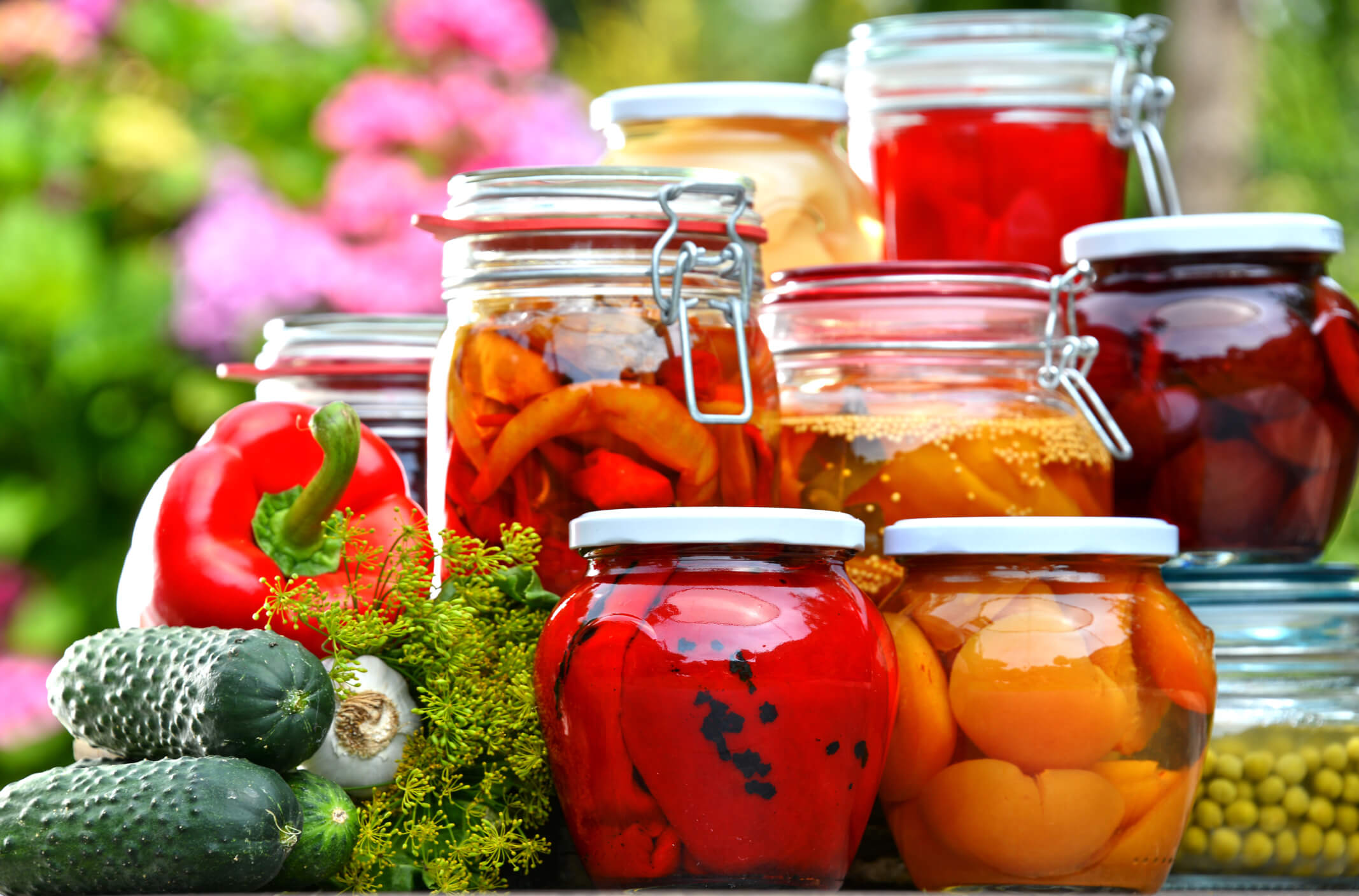
Pic source-kitsilano.ca
Food preservation can be defined “As the science which deals with the process of prevention of spoilage of food thus allowing it to be store in a fit condition for future use”.
It can also be described as the state in which any food may be retained over a period of time without:-
(1) Being contaminated by pathogenic organisms or chemicals
(2) Losing optimum qualities of colour, texture, flavour and nutritive value.
What does Spoilage means:-
Spoilage means deterioration of food items to such an extent that it becomes unsafe for human consumption. Deterioration of food will also result in loss of its quality, flavour, texture, color, Nutritional value & sensory properties etc.
The main factors for food deterioration are: –
- Physical agents (hair, nails, nuts& volts, wood etc),
- Chemical agents (toxic chemicals, pesticides, soap & detergents etc), Biological agents (bacteria, virus, fungus, yeast & molds etc)
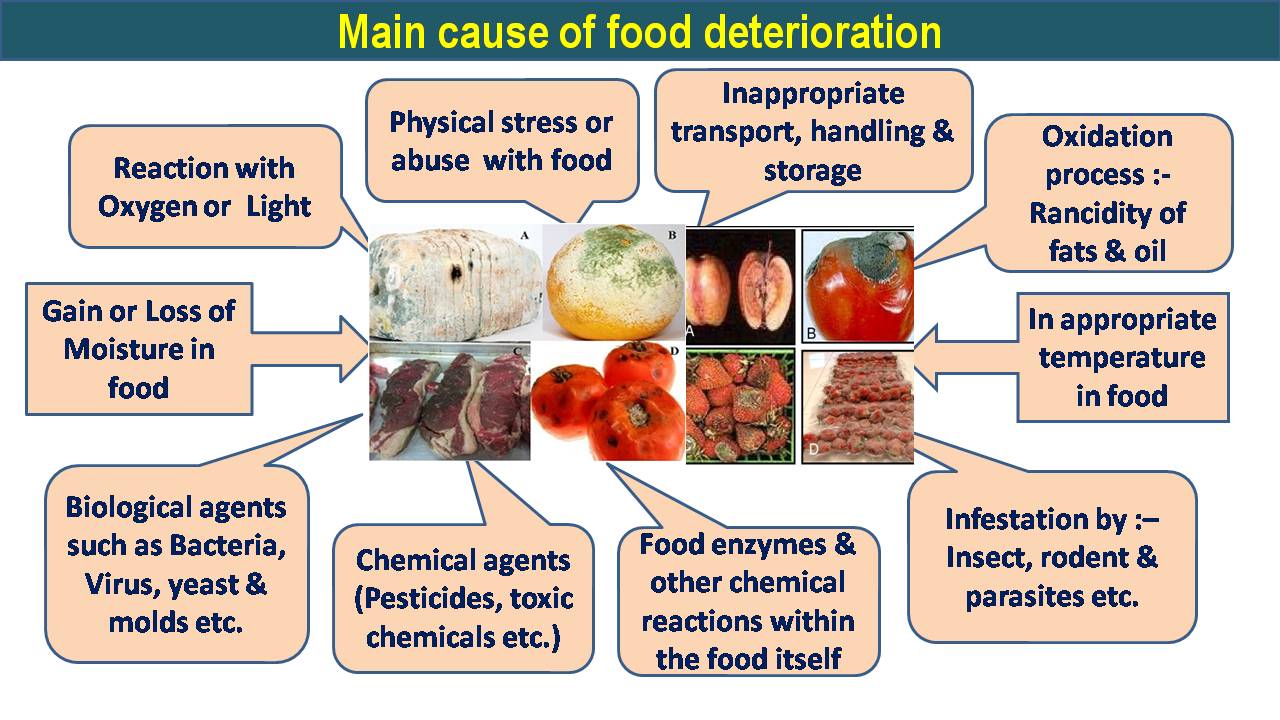
Importance of Food Preservation:-
Preservation methods help inhibits bacterial growth and other types of spoilage, meaning the food is safe and satisfying to eat in the future.
03 basic reasons why food preservation is important:-
- To minimise pathogenic bacteria in Food:-Perishable food items are more susceptible for spoilage due to pathogenic bacteria such as E coli, Salmonella etc. Bacteria require Food, Acidity, temperature, time, oxygen & moisture (FATTOM) to multiply very fast in food BUT food preservation inhibits one or more of these conditions & stops their growths.
- To keep food at its best quality:- Food deteriorates over time due to spoilage. Mild spoilage in food can significantly affects its taste, texture, color, appearance & nutritional value etc. That is the reason proper food preservation is very important to retain these qualities & make safe for human consumption as well as preserve the nutritional value in food. This also helps in making the seasonal food available throughout the year, Increasing the self-life of foods thus increasing the supply.
- Wastage control & save money–Food preservation not only control waste but also save lot of money. Decreasing wastage of food by preventing decay or spoilage of food. Wastage control on food also helps in stabilising prices of food as there is less scope of shortage of supply to demand.
A brief history of food preservation:-
Several techniques were used to preserve the food or to extend the shelf life of food much before the refrigeration technique invented by humans such as salting, drying, pickling & smoking etc.
Food by nature starts to spoil immediately after harvesting. In order to survive, ancient people find a way to keep their food for longer time especially during the lean period when the food is not harvested or made available for them. In cold or frozen climate, they started freezing their meat on the bed of Ice whereas in tropical climate, they started drying their food in the sunlight. Chilling on ice bed & sun drying was the 1st technique of food preservation by our ancient people. Sun & Wind play an important role in drying their food. Early evidence have shown that Romans were used to sun dried their fruits, meat & other food items
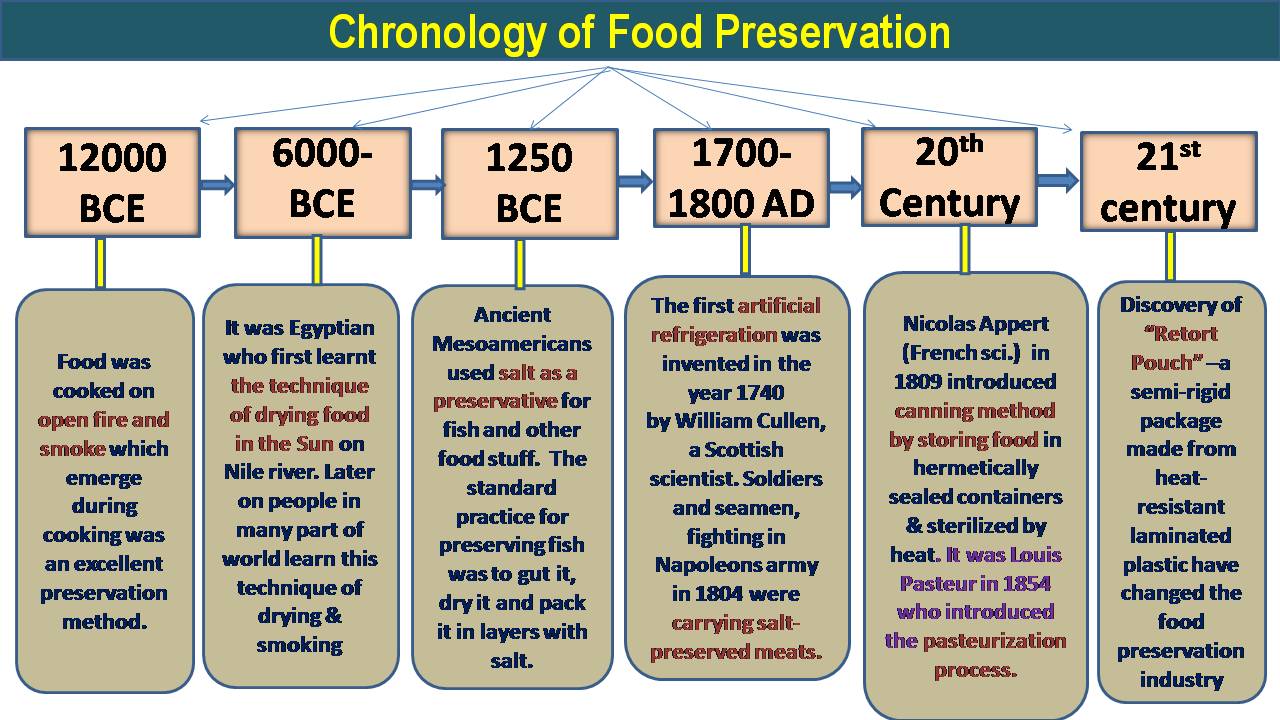
Food Preservation technique from ancient times till date
- Drying & smoking method of food preservation:-
Drying & smoking is one of the most popular ancient methods of food preservation known to mankind. They use to preserve the food items by sun drying or hotter climate such as dessert area to remove water by evaporation from food. Removing the moisture from food helps prevent bacterial and fungal growth.
Drying is the process of dehydrating foods until there is not enough moisture to support microbial activity. It can be applied to most of the food items such as fruits, vegetables, meats, seafood, grains, legumes, and nuts etc.

In ancient times sun drying to preserve their food items were practice throughout the world. For example, Egyptian people used to dry their fish, meat, nuts & even fruit in the sun whereas Romans were also found of drying fruits in dehydrator. Indian people were known for drying their chillies, mangoes & lot of spices.
To dry their food items they used to tie them together and hang in the open area where sun light & natural air dry out the moisture in the food items. Those food which cannot be hanged were used to sun dry by spreading it on surface or cloths in the direct sun light. Fish & shellfish were usually sundried by hanging on the coastal area whereas meat & poultry items were sun dried on the mountainous area.
Picture of sun drying of meat & vegetables:-
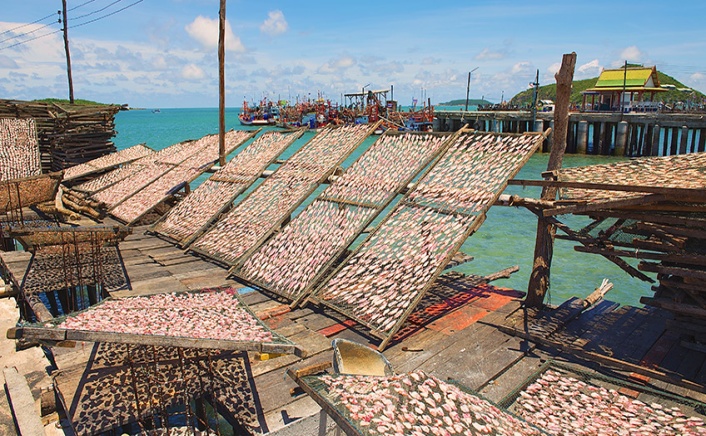
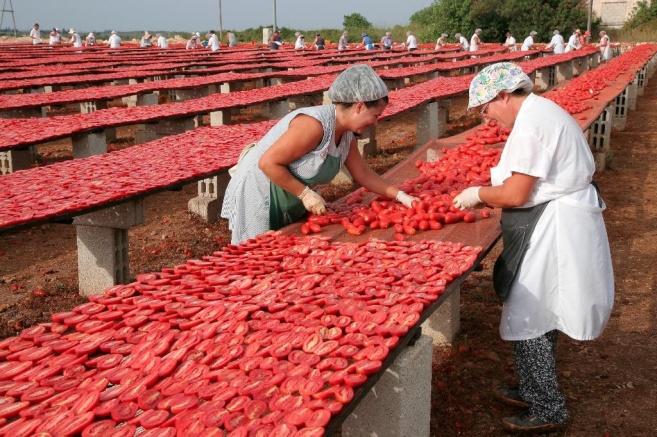
Pic source-wonderlandguide & cookwithgusto
During the middle age, people started building “still houses” to dry their fruit & vegetables, herbs etc in area where sunlight is not so strong for drying. They use fire to create heat & smoke in the still room to dry & smoke their food. Smoking also imparts flavour to the food items especially meat, poultry & fish items etc and smoke helps to keep bacteria or insect away during the drying process.
- Smoking method of food preservation:-
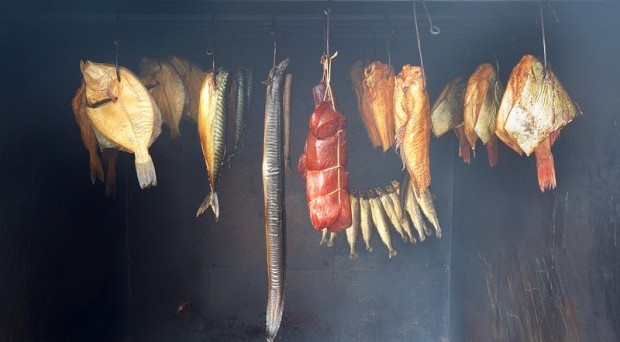
Pic source-survivopedia
Smoking is also the oldest method of food preservation and could have developed immediately after fire was discovered. It is basically a method of cooking meat & other food by exposing it to smoke from burning wood or charcoal to give a smoky flavour. Smoking is separate from drying as it adds flavour to meat, fish, poultry & other food items and provides a small food preservation effect due to its (smoke) antimicrobial & antioxidant properties and used to preserve food since ancient times.
Science behind smoking:-Smoking is usually done in an enclosed chamber where food is cooked slowly in direct contact with smoke. Hardwoods are usually preferred in smoking process because it burn very slow. Sugar which is found in the wood including cellulose & hemicelluloses impart color & flavour to the smoked product whereas Phenolic compounds in the wood act as antioxidants in the smoke. Also during the smoking of the wood “Formaldehyde & Acetic acid” are produced which lower the pH Level of food and act as a preservatives.
What is the Best Wood for Smoking Meat?
When it comes to smoking meat, as a thumb rule hardwood is recommended for heavier meat such as Red meat, pork etc whereas for delicate meat like poultry & fish items lighter hardwood are recommended.
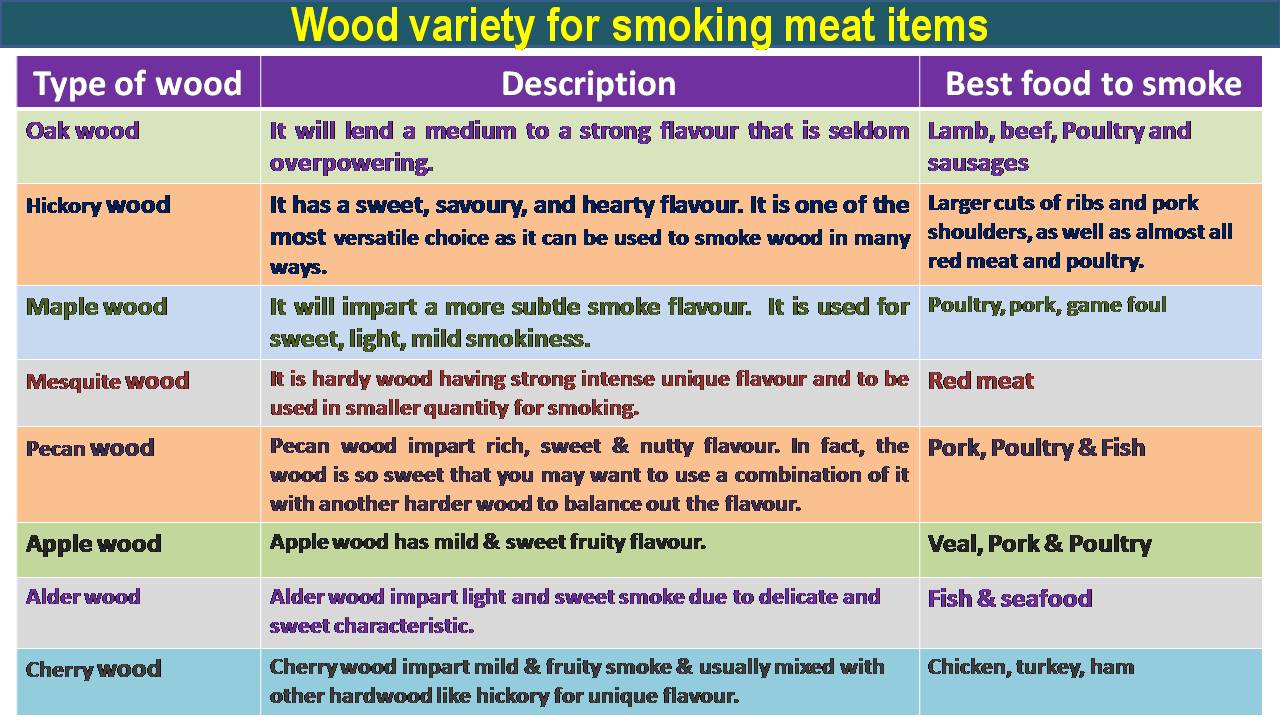
The most common smoked food are:- meat, poultry & fish items. Although cheese, nuts & vegetables are also smoked. In Scandinavian countries smoking of fish such as salmon, herring, tuna etc are one of the most popular while smoking of meat items like ham, bacon, poultry products are very popular in European country as well as USA.
Type of smoking:-
There are two types of smoking: – Cold smoking & Hot Smoking
Cold Smoking:-Cold smoking is basically used to dry & preserve the food items by application by low heat smoke which is usually 27°C or below 30°C/86°F. At this temperature, food product does not cooked but actually dried. Food which is to be cold smoked are often cured or brined before smoking. Cold smoking is usually done in a chamber or smokehouse where cold smoke is injected for an hours upto several days or week depending on the food which is cold smoked and temperature of smoke is closely monitored to prevent food does not cook.

Pic source-dBites
Important point to mention here that:- Since cold smoking are usually done at 27°C or below 30°C/86°F and this temperature are very ideal for rapid microbial growth in food items therefore only those food items that have been fermented, salted or cured are recommended for cold smoking.
Cold-smoked meat products must be cooked to an internal temperature of 160°F before eating whereas cold smoked fish & shellfish items such as smoked salmon, cold smoked mackerel are also advised to cook this to an internal temperature of at least 140 °F before consuming
Hot smoking:-Hot smoking are generally used to cook the food items directly on expose to smoke at temperature range between 52°C to 80°C. This temperature of smoke is enough to cook food fully by retaining the moisture & flavour. If temperature of hot smoke is higher than 85°C then food items will dry out as most of its moisture will evaporate from food items & fat will also melt and run out. Hot smoking foods are exposed to smoke in a controlled environment. Hot smoking is done in the smokehouse or more modern electric kilns, usually over a short period of time, just until the meat is cooked.
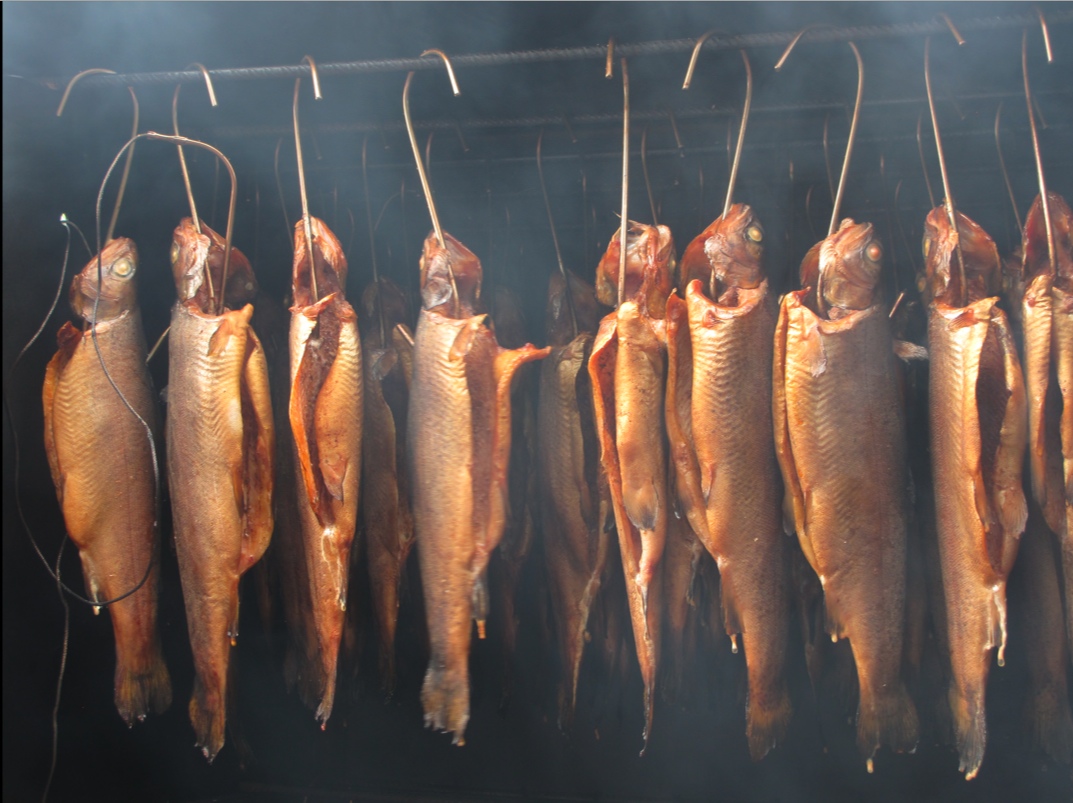
Pic source-Kitchen theory
- Curing method of food preservation:-
Curing is also an ancient method of food preservation. The word Curing is derived from Latin word cura-ae means to take care of it or care. Before the development of refrigerator, salt were used for preserving meat, poultry & fish items for longer time & for food trade. Around 1250BC Phoenicians used to preserve their fish by gutting, drying & then packing it in layers with salt.
The Roman people learnt this technique of salt curing from Greeks and besides curing fish, they also started curing various types of meat such as pork & beef etc. It was during this time only that the reddening effect of salt was noted.
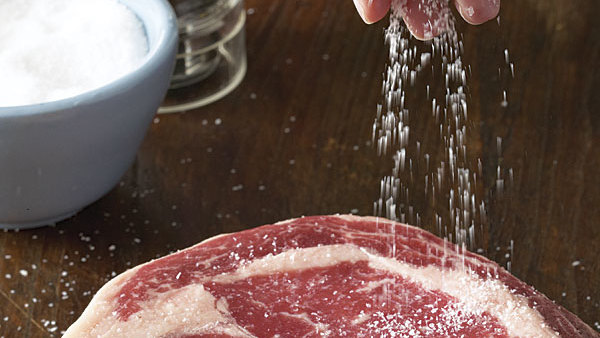
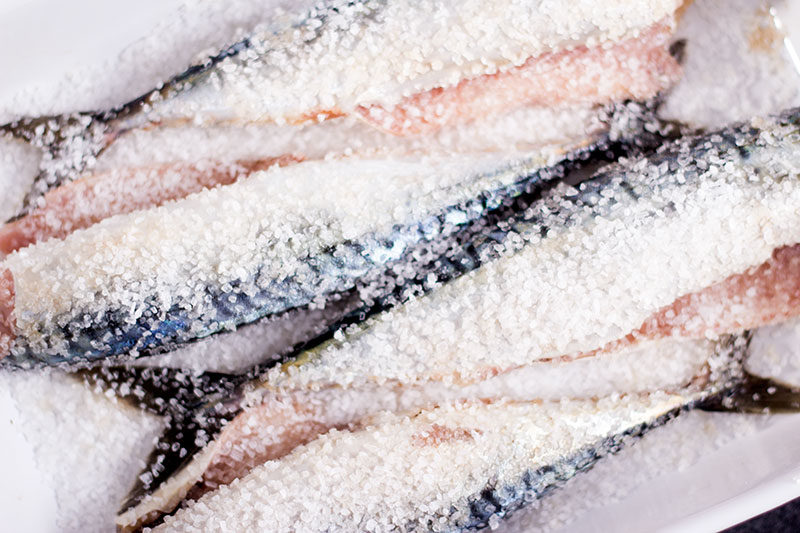
Pic source-fine cooking & Go fish
Osmosis process in salting:- Osmosis is the movement of higher concentration of water to a lower concentration of water through a semi-permeable membrane.

Pic source-Scientific american
For example:- when food is placed in strong solution of salt or brine higher than solution of salt in food. Then penetration of salt in the food occurs and withdraw the water from the food. When salt concentration in food gets equal to the salting mixture or brine solution in which food is kept for preservation then, penetration of salt end in food. This phenomenon is commonly known as Osmosis. This process facilitates preservation of food by reducing the water activity in the food.
Types of Curing:-
There are basically two type of curing:-Dry curing & Wet curing (Brining)
Science behind Salting or dry curing:-
Salting is usually done alone or in combination with drying method or as a pre-treatment to cold smoking of food preservation. Salt prevent the growth of spoilage-causing microorganism by drawing water out from food microbial cells through osmosis. Concentrations of salt upto 20% are require to kill most of unwanted bacteria from food for preservation.
Curing break down & tenderizes tough protein & fibre in meats. Salt curing also make food more concentrated in flavour & denser texture.
Common salt Vs Curing salt
Common salt:- Common salt in its purest form consist of upto 99.9% Sodium chloride (NaCl). However almost all the commercial salt contains some level of impurities in it which depends on their method of production & processing. Low quality of common salt may only contains approx 80% of sodium chloride and rest are chemical impurities such as Calcium, magnesium chlorides, sulphates, sodium sulphate, carbonate & traces of minerals like copper & Iron etc.
Fine grain of salt will dissolve easily & rapidly in water and mainly preferred for making brining. However fine grain salt should be avoided for direct use on food such as fish or meat during salting because it will rapidly removed water from the surface of the food and food outer surface become hard & will prevent the further penetration of salt inside the food. In these conditions it is commonly referred as “Salt burn” .Hence for dry salting a mixture of large & smaller grain/fine grain of salt is preferred.
Presence of impurities in common salt like Calcium & Magnesium chlorides even in small quantities will slow down the penetration of salt in the food items especially in meat, fish & poultry during food preservation and will spoil fast. Also calcium & magnesium salt impart white color & bitter taste.
Curing Salt:-Curing salt are mixture of common salt i.e Sodium Chloride (NaCl), Sodium Nitrite (NaNO2) and Sodium Nitrate (NaNO3) in varying ratio depending on the type of curing salt used for preserving specially meat, fish &poultry products to make sausage or cured meat such as ham, bacon, pastrami, corned beef etc. The reason for using nitrite-curing salt is to add an extra level of safety as it prevents the growth of specially “Clostridium botulinum” bacteria in an effort to prevent botulism. Curing salts are commonly known as Prague Powder are essential in food preservation.
Sodium Nitrite (NaNO2) and Sodium Nitrate (NaNO3) not only help to kill Clostridium botulinum bacteria in meat but also impart good flavour & pink to red color to salt cured meat.
Type of Curing Salt:-
There are 02 main type of curing salt are used in food preservation especially meat preservation-
- Prague Powder #1 :- It is the mixture of common salt i.e Sodium choloride (Nacl) of 93.75% & Sodium Nitrite (NaNO2) of 6.25% with some anti caking agent as well as little bit pin color to easily identify its type as it contains sodium nitrite. Prague power #1 is also commonly known by several names such as Instacure#1, Pink curing salt #1 & Quick Cure salt.
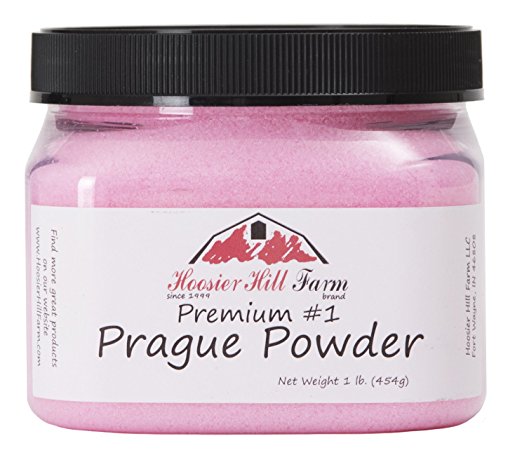
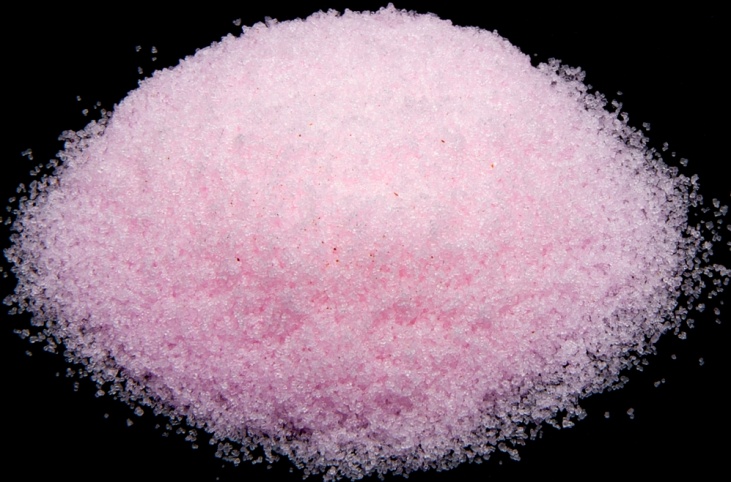
Pic source-preserve & pickle
Use:- Since Prague powder #1 works quickly to cure meat therefore it is mainly used on meat that need to be salt cured for shorter period & require further cooking before eating. For example bacon, sausage, Ham, corned beef are usually cured by Prague powder #1.
Recommended quantity of Prague powder#1 for salt curing meat are:- 2.5 gms of curing salt per 01 kg of meat.
- Prague Powder #2:- It is the mixture of Common salt i.e Sodium choloride (Nacl) of 89 % , Sodium Nitrite (NaNO2) of 6.25% & Sodium Nitrate (NaNO3) of 4.75% with some anti caking agent & pink color.
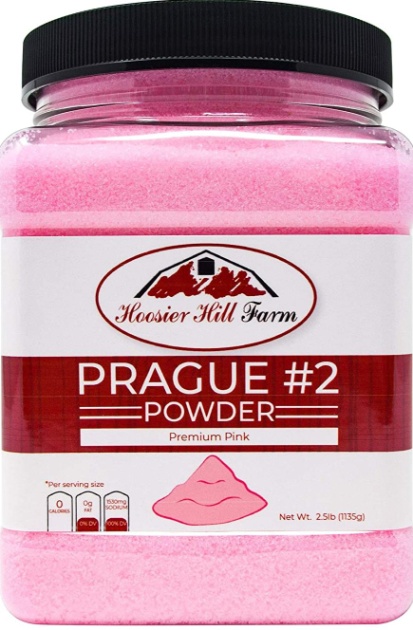
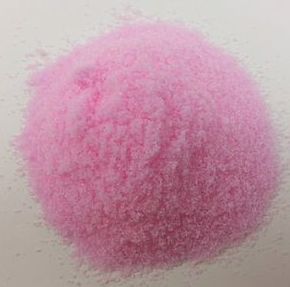
Pic source-Amazon.com
Use:- Due to the presence of Sodium Nitrate (NaNO3) in this curing salt it is applicable for longer cured meat that does not require further cooking before eating. Meat items which is salt cured with this Prague powder#2 will last over upto months as nitrates slowly convert to nitrites as the meat cures. Product such as Salami, air-dried hams like Serrano ham & Prosciutto ham are prepared using Prague powder#2.
Recommended quantity of prague power #2 for salt curing meat are:– 2.5 grams per kg of meat.
- Brining (Wet curing) method of food preservation
What is Brine (wet curing)?
Brine is basically high concentration of salt solution in water with seasoning/flavouring used for curing & preserving food items. Food products especially meat, poultry & fish items are soaked in brine solution to improve overall quality of texture & flavour of food as well as retention of its moisture in it.
What is brining or wet curing?
Brining is the process of fully submerging the food items specially meat, poultry & fish items into a chilled solution of salt cure or brine. Brining is also known as wet curing, corning or sweet pickling. Brining is done under refrigeration at 36-40° F (2-5° C) and brine should be fully cooled before use.
The main advantage of wet curing is that: – This process takes less time than dry curing process of meat. Also it is easier to control the humidity while wet curing and due to lack of oxygen in this process bacteria does not get chance to grow faster in meat.
Can ocean water be considered brine?
Technically No, because salinity in the seawater is lower than the salinity in the brine. Seawater is salt water from sea or Ocean which has an average salinity of about 3.5% in the world oceans. This means every kilogram (roughly one litre by volume) of seawater has approx 35gms of dissolved salts (NACL). The salinity in seawater varies from one region to another across the world’s oceans due to temperature, evaporation & precipitation. Salinity is generally low at equator and at the poles whereas salinity is high at mid-latitudes area.
Technically seawater is just a salt water or saline water and does not contain any flavouring & seasoning as in case of brine.
Brining is more art than science:-
The salt concentration in water can vary from 5% to 26% depending upon the use of brine solution for curing or preserving different types of food.
There is No universal brining recipe for curing meat. Weak brine (5 – 14%) having low salt concentration increase the curing time where as strong brining having higher salt concentration( 15 to 26%) reduces the curing time. Weak brining is mainly used for curing poultry & Fish whereas strong brining is for red meat, pork, game meat etc.
Picture of Turkey soaked in brine
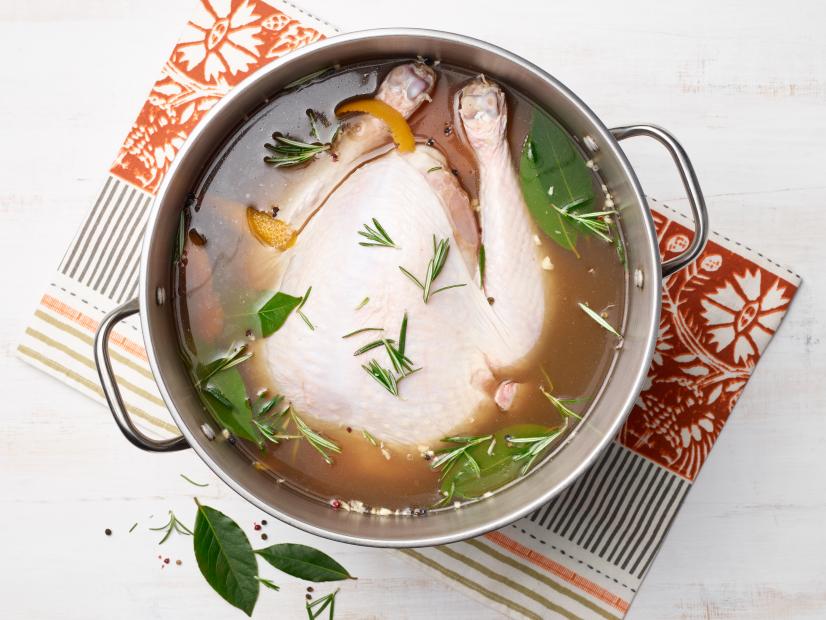
Pic source-Foodnetwork
Component of brine solution:-
A brine solution usually contains the following:-
- Liquid :- Water is the most common liquid in brine, however stock, wine or fruit Juice can also be used as a liquid in the preparation of brine)
- Salt (NaCl): – Salt is the key ingredient in any brine. Many brining recipe do not specify the type of salt. However pickling, canning or kosher salt is considered best choice for brining recipe because it is pure & dissolve easily.
Table salt & sea salt are not preferred generally in brining due to additives or mineral contains in it which can inhibit the curing process.
Kosher salt is consider perfect for brining because it the pure salt with No additives and the flaky crystal of kosher salt dissolve extremely well in water and create a crystal clear brine.
Kosher salt is lighter in weight than table salt. Usually table salt is twice heavier than kosher salt which means 01 tsp of table salt will be equal to approx 2tsp of kosher salt in weight.
- Curing Salt:-Curing salt is mainly added to enhance color, piquancy, texture & reduce the risk of specifically Clostridium botulinum in an effort to prevent botulism bacteria growth especially in the meat processing or meat brining. The active ingredients in the curing salt are: – Sodium nitrate (NaNO3) & Sodium nitrite (NaNO2). Example of curing salt are: Prague powder-# 1,
- Sugar:- Sugar contribute sweetness and mainly added in brining to balance the saltiness & spices and also act as a preservative. Most common type of sweeteners used in brining preparation are- Common sugar, dextrose, honey, maple syrup, corn syrup etc.
- Spices & herbs:-Spices & herbs are mainly used for adding flavouring & aroma to the brine. Most common spices & herbs used in brining are- Onion powder, onion & garlic powder, five spices powder, garam masala powder, jerk spices, peppercorns, broth powder, Thymes, sage, rosemary, bay leaves etc.
- Aromatic vegetables:-Aromatic vegetables such as onion, garlic, celery, leek, carrot, fennel etc are usually added to brine solution to further improve the flavouring of the brine solution.
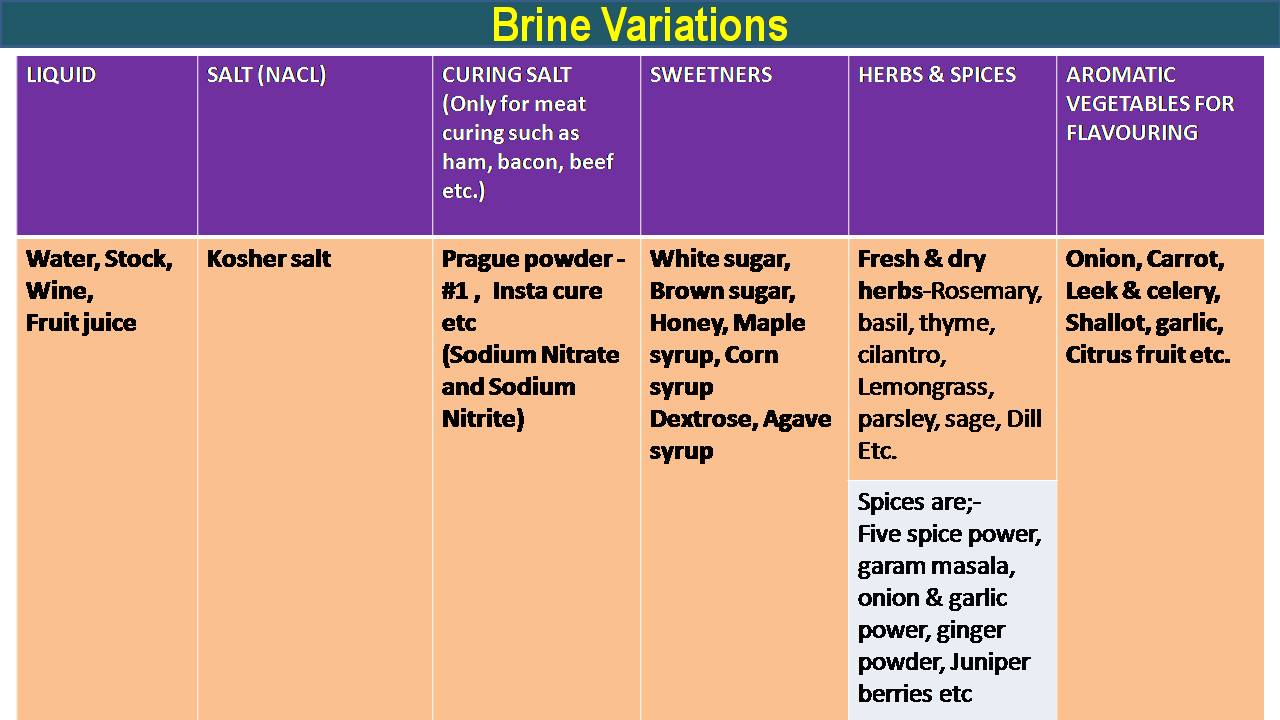
How does brining works? (Science behind brining):-
As we know that proteins denature/unwound when exposed to heat or alcohol/acid and losses upto 30% of moisture from the food items during the process.
Brining also promote a change in the structure of the protein in the muscle and de-nature or unwound protein in the same way as exposed to heat or alcohol. Submerging meat or poultry in brines causes some of the proteins to denature and unwinds the muscle fibres causing them to swell & breaks forming a matrix that traps moisture resulting it reduces the moisture loss by as much as 50% as compare to heat or alcohol exposure to food and the resultant product is moist & plump finished product.
Three basic functions accomplished by brining are:-
- Keep the food items juicy as moisture loss is less than 50%.
- It helps to dissolve some of the muscle fibers, which helps to reduce the toughness of meat.
- It de-nature protein, essentially unfolding and unravelling them. As they unfold, water works its way in between these proteins so there is more water in between the meat proteins as the meat cooks. This results in a more tender cooked meat.
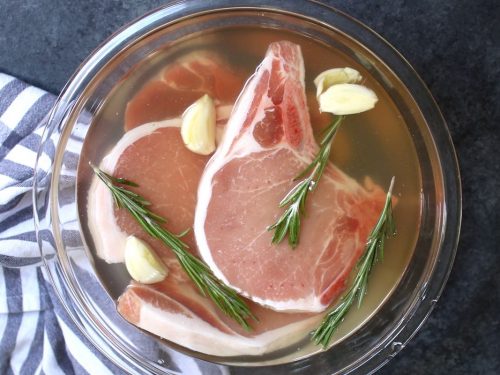
Pic source-Tip Buzz
Is there any device or tool for checking the salt in brining solution:-
Yes, by Brinometers or Salinometer
A Brinometer is used to measure the percentage of saturated solution of brine in water at 15.6°C (60°F). It is manufactured from hygienic glass and simply floats in the brine solution to give an instant, simple and clear reading.
Brinometer measure salt concentration in brine in percentage value (% value)
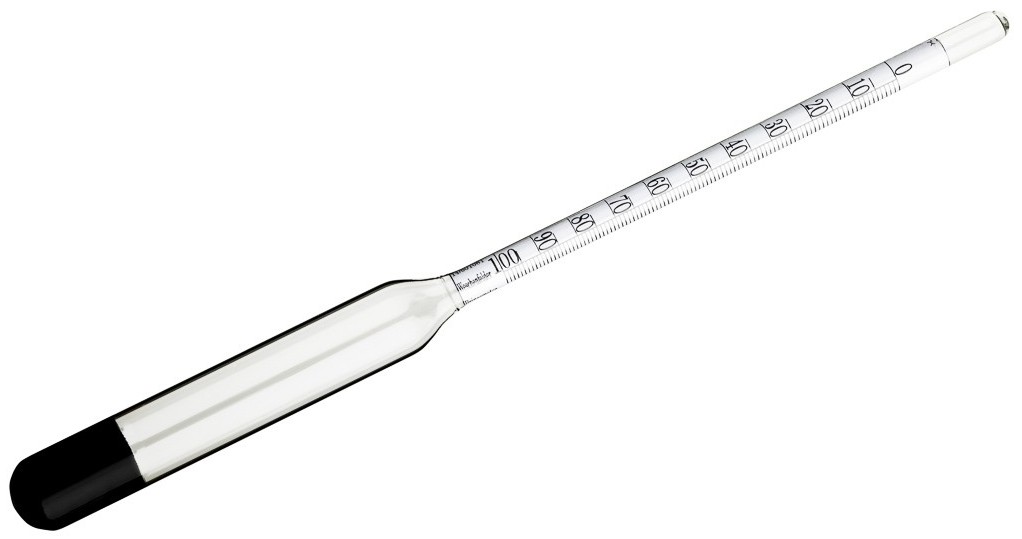
Brines are also measured in degrees by the amount of salinity in the water with the use of a salinometer.
A salinometer is a machine that is capable of measuring the table salt (NaCl) content in degree. Another name for a salinometer is a conductivity meter, as dissolved salt in water will increase its ability to conduct electricity at measurable levels.
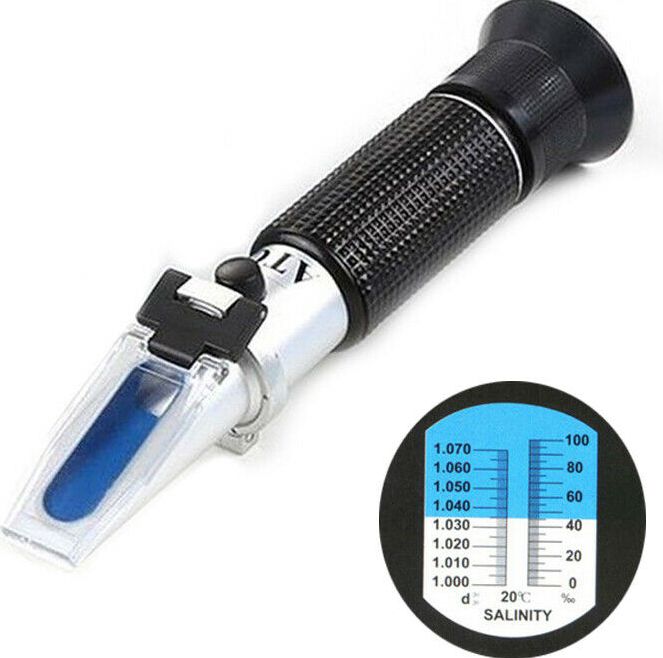
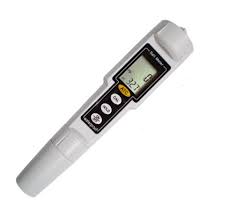
Pic source-ebay &Ali express
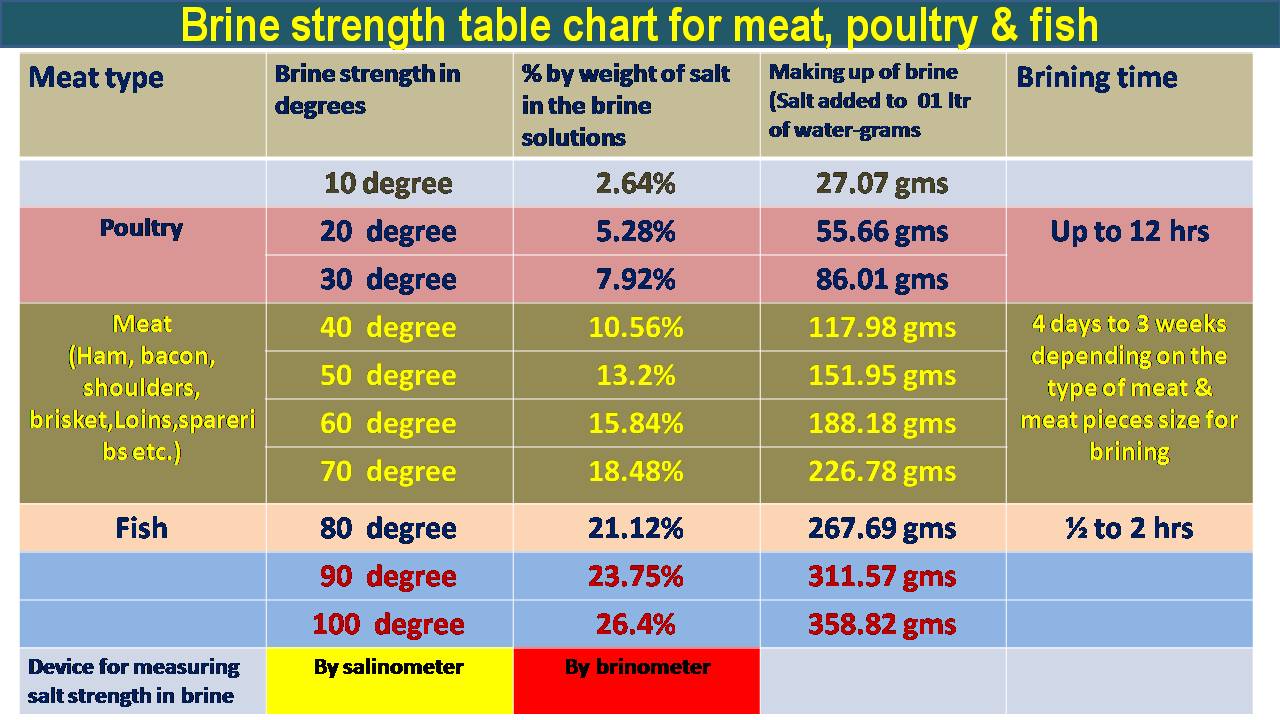
Brining time guidelines:-
Brining times depends on the following factors:-
- Strength of the brine:- it means stronger the brine, faster the curing process & weaker the brine, slower the curing process of the food items.
- Size of the cured food items:– brining time depends on the size of the food items. It means larger cuts of meat or large pieces of meat will take more time than smaller size of the meat.
- Type of food items:– Red meat require longer time for brining as compare to poultry & fish items.
- The simplest way to calculate the quantity of brine required for brining is twice of the weight of the product. That means 04 ltr of brine solution for 2kg of meat.
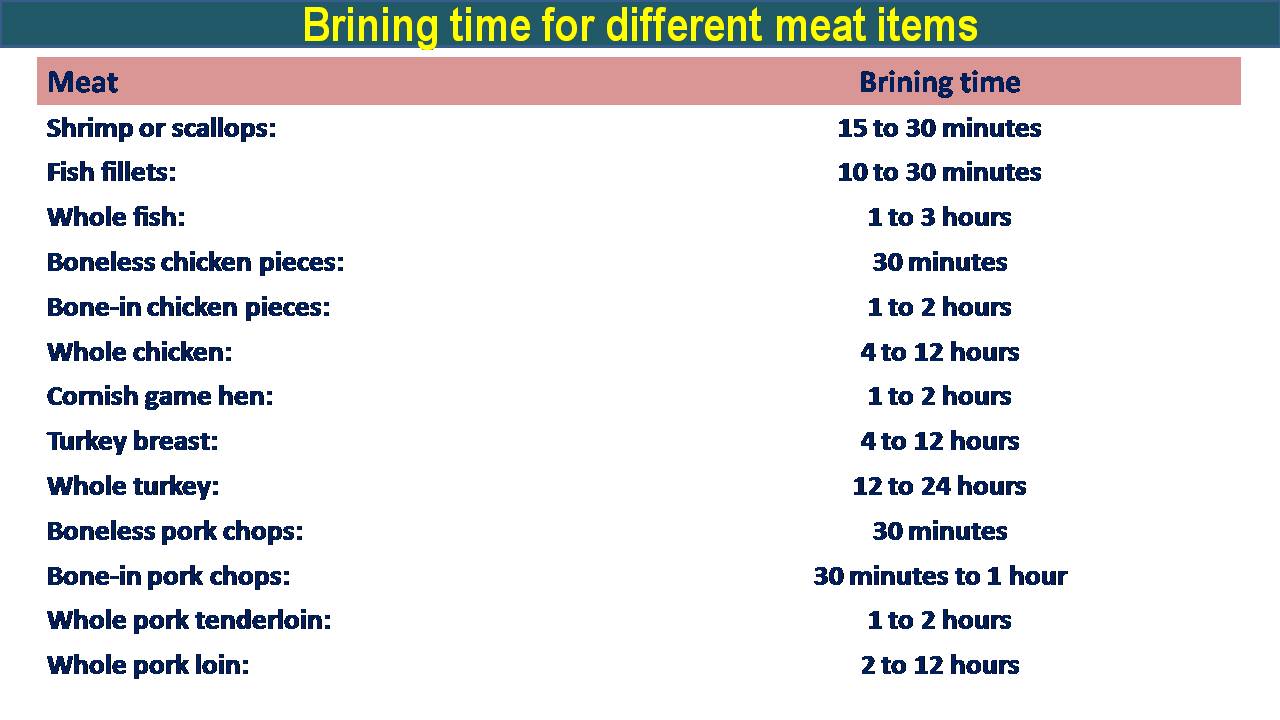
What is Marinades:-
Marinades is a seasoned liquid generally a mixture of Oi, acidic ingrident such as wine & vinegar or citrus juice with various seasoning & aromatics in which meat , poultry, games, fish & shell fish, fruit & vegetables etc are dipped into it for few minutes to hrs to make it tender & softer, tastier & flavourful etc. Using a Marinade is called “Marinating.”
Marinades can be cooked prior to adding it in the food item for marinating. Raw marinades are ideal for long time period. Cooked marinades should be store in refrigeration and has longer shelf life whereas raw marinades or uncooked marinades are prepared for immediate use.

Pic source- onthegas.org
Component of marinades:-
Oil:- Extra virgin oil are generally preferred for marinades. Refined oil is also very good option as it is neutral in flavour. We can also use flavour oil such as garlic oil, herb flavour oil, chilly oil. Oil mainly prevent moisture lose in food while cooking & impart flavour & nutritional value in food. It also makes food to cook faster.
Acidic ingredients:- A wide range of acidic ingredients are used in marinades such as Citrus fruit & Juice like lemon juice or orange, Vinegar, Wine, Curd , butter milk,etc.
Tenderizing agent:- certain fruits naturally contains tenderizing agents such as enzymes which are used to tenderize tough cuts of meat. Example of such fruits are:- raw Papaya, raw pineapple, kiwi, honeydew melon & figs etc.
Herbs, spices & seasoning:- Fresh herbs & dry herbs both can be used in the marinades, spices should be grounded finely before use in marinades. Aromatic ingredients such as proprietary sauce & paste like HP Sauce, tobacco sauce, Worcester sauce etc & seasoning like salt & pepper.
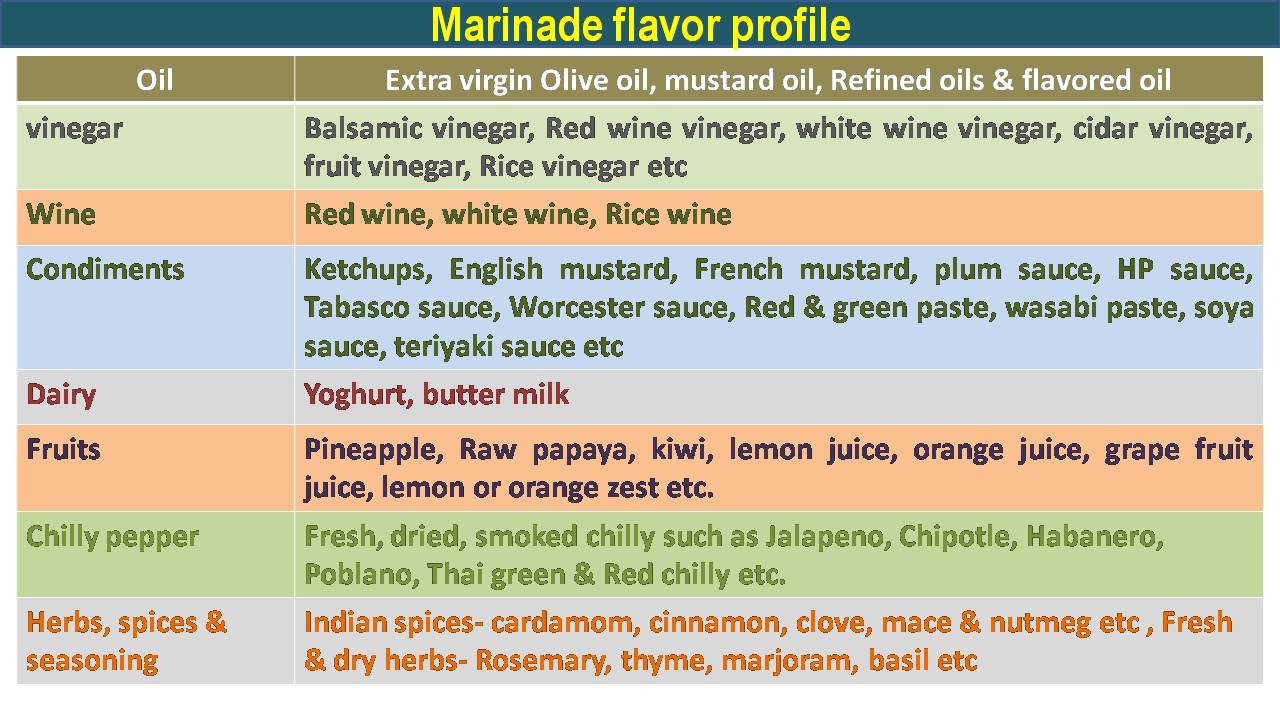
Purpose of marinades:-
Main purpose of marinades is to tenderize the meat items as Marinades help to break down the elastin in meats so that it is cooked easily in dry heat method. It also enhance the flavour of the food items and well as it act as a short term preservation to food.
Types of marinades:-
There are two types of marinades:-
- Acidic based marinades:- Acidic based marinades usually contains acidic product as a base such as Citrus fruit & Juice like lemon juice or orange, Vinegar, Wine, Curd etc. In India Curd & butter milk are generally used. The acid loosens bonds between proteins in the meat causing it to unravel and loosen up and make the meat more softer & tender.
The ratio of Oil, Acidic ingredients & Seasoning in acidic based marinades are usually:-
Oil (01 part) : Acidic ingredient (02 part) : pinch of spices, herbs, aromatic & seasoning.
Use:- Acidic based marinades are generally used to tenderize prime cuts of meat items. All the meat, poultry, fish & shell fish items require to be put in marinades for few minutes to hrs before it is applied for dry heat method of cooking such as baking, roasting, grilling, barbequing, tandoori cooking etc.
- Enzymatic based marinades:-
Enzymatic based marinades contains tenderizing fruits which has enzymatic properties to tenderize tough cuts of meat. Example of such fruits are:- raw Papaya, raw pineapple, kiwi, honeydew melon & figs etc. Papain or bromelain, in fruits such as kiwi, papaya leaves or Raw papaya fruit, pineapple, etc. actually break down muscle fibre.
Tough cuts of meat must be marinated in enzymatic based marinades for at least 4hrs before cooking.
- Canning method of food preservation:-
Canning is a food preservation method in which food is packed in a hermetically sealed container & sterilized it by heat application to eliminate all microorganisms which can spoil the food with have minimal impact on the nutritional and physical qualities of the food.. Canning is the most efficient preservation method for low acidic food such as meat, fish & poultry and vegetables items.
Low acidic foods are mainly preferred for canning. It is usually heated at 121 °C to sterlize it to eliminate all the mesophilic microorganism as well as spores of clostridium botulinum.
Canning sterilizes food by heat it at 121 °C in airtight containers which allows food to be stored at room temperature for months or even years. Canning generally provide 1-3 years of shelf life of food items.
Type of containers used in canning:- Variety of food container are used for canning process such as metal cans, glass Jars, plastic & foil laminated pouches, semi-rigid plastic bowl or containers etc.
Discovery of canning method of food preservation:-
During the beginning of 19th century Napoleons Bonaparte army during the Napoleonic war from 1804-1809 used to give their soldiers & seamen salt preserved meat as a food. Salt preserved meat or salt cured food was having very minimal nutritional value and cannot meet their soldier’s expectation. It was Napoleons Bonaparte who encouraged scientist by offering 12000 franc to discover new & better mechanism of food preservation.
Nicolas Appert (French Chemist) in the year 1809 has discovered new & better mechanism of curing/salt curing. He found that food heated in sealed containers can be preserved as long as the containers remains unopened & accordingly introduced canning method by storing food in hermetically sealed containers & sterilized by heat. Because of heat treatment, it eliminates all microorganisms including pathogenic bacteria which can harmful for human and can spoil the food. Now a days most of the commercial canning operation are based on the principal that microorganism destruction increases 10times for every 10 degree C increase in temperature. Food exposed to higher temperature for few seconds to a minute can able to retain more of its natural flavour. After this discovery Nicolas Appert was recognized as Father of Canning who invented the airtight container for food preservation.
Picture of Nicolas Appert (Father of canning) Inventor of Airtight Food Preservation
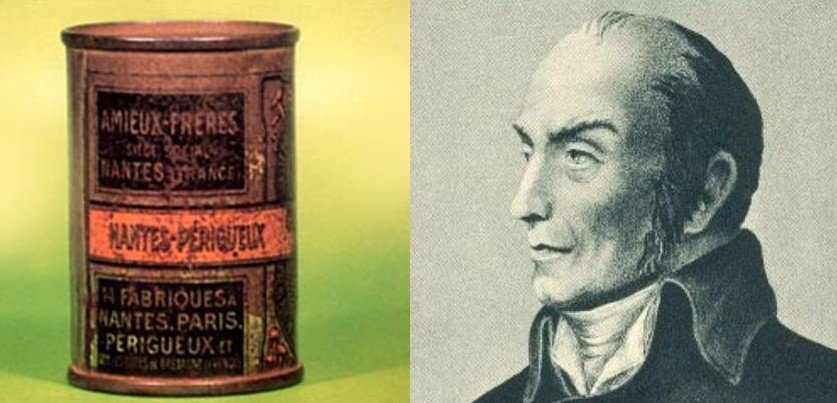
Pic source-Grub americana
After 50years from the discovery of canning method by Nicolas Appert, another major breakthrough had occurred in the improvement of food canning process by Frenchman Louis Pasteur who noted the relationship between microorganism & food spoilage and find out which microorganism leads to food spoilage during canning process.
Louis Pasteur(1822-1895) discoveries established the evidence related to germs to diseases and cause of many diseases were identified. He is hence known as father of germ theory or founder of bacteriology. Louis Pasteur has invented the technique of pasteurization & patent it in the year 1865 which is widely used to great milk in these modern days. He also
Picture of Louis Pasteur in his laboratory,
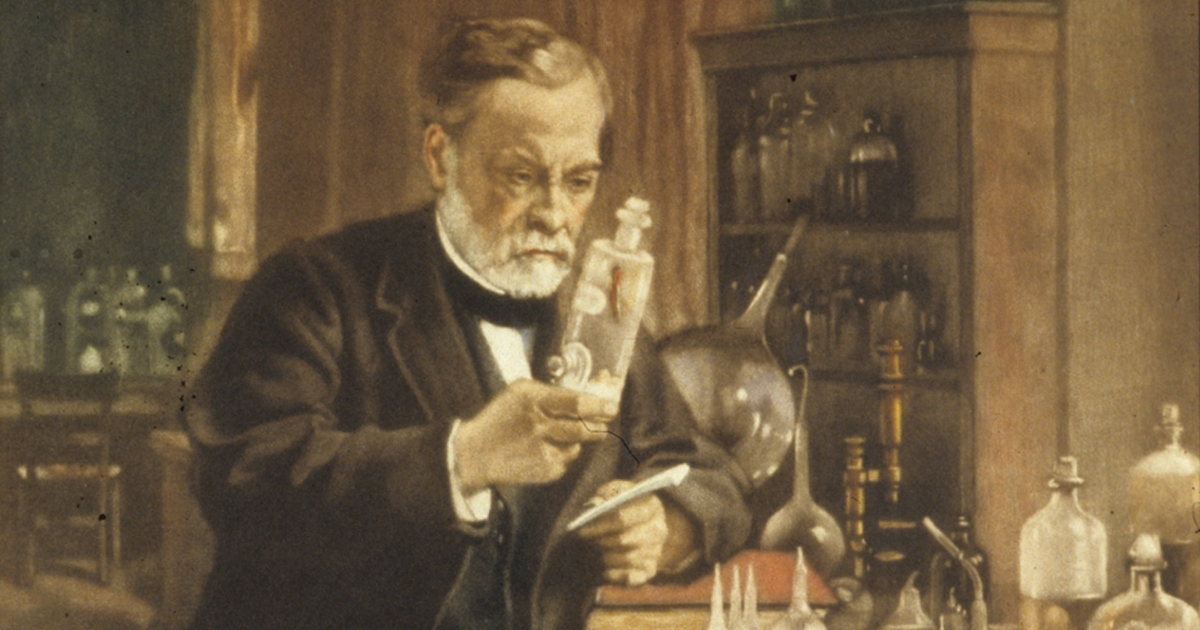
Picture source-science history.org
- Retort pouches method of food preservation
United state military in the late 1940 initiated to switching from rigid food cans to a flexible bouches for individual combat rations resulting after few years of research discovery of “retort pouches” came into existence in the year 1960. The retort pouch was invented by U.S Army Natick R&D Command,Reynolds metal company & continental flexible packaging co.
The greatest advantage of Retort packaging is more efficient use of packaging materials as well as packing space as compare to metal cans. It reduces costs of storages as well as transportation, waste for disposal etc. After the discovery of Retort pouches it totally transform the food packaging industry in 21st century.
Later on Japanese & European firms obtains this Retort pouches technology from USA through licensing agreement after 1960s.
Picture of internal structure of Retort pouches:-
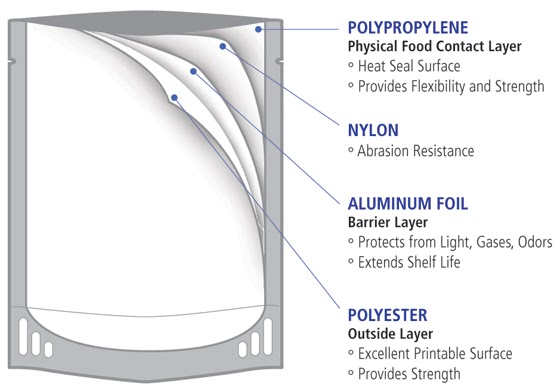
Pic source-bizongo.com
The retort pouches are generally contains 4 layers:-
- The 1st Layer is propylene which act as a heat seal and provide flexibility and good strength to pouches.
- The 2nd layer is made of Nylon which protect from abrasion, 3rd layer is made up of aluminium which protect from direct light, gases and odor in food and provide extended shelf life.
- Last layer i.e 4th layer is made of polyester which provides excellent strength & it is also very easy to print food description on the retort pouches.

Pic source- standuppouches.net
- Modified atmospheric packaging (MAP):-
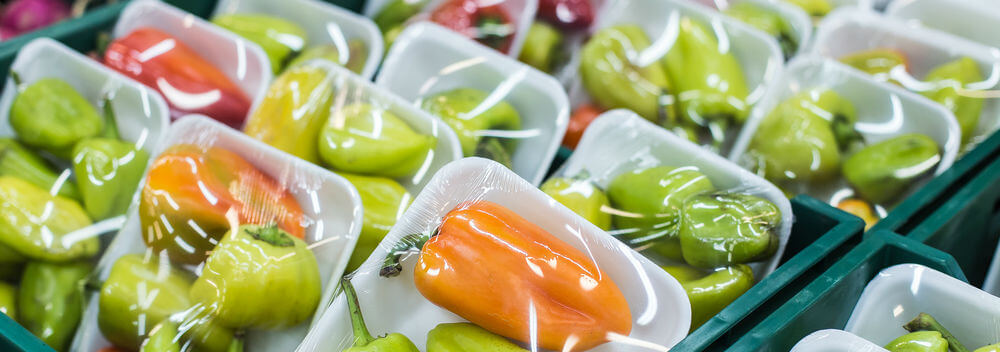
Pic source-generon
MAP was first recorded in the year 1927 by storing it in atmosphere with reduced oxygen (O2) & increased Co2 gas Concentration for extending the shelf life of apple. Later in 1930, it was first successfully used to transport fruit & beef meat carcasses in ships for long distance transport by increasing Co2 concentration & reducing oxygen and they observed 100% increase in shelf life of food items. Although this technique was not introduced commercially for retail packs until 1970 in Europe.
Marsk & Spencer company of UK introduced MAP Technology for meat packing & transportation in 1979 & later the introduction of MAP for fish & shellfish, bacon, cooked meat etc & other food manufacture & supermarket chain adopted this technique to increase in consumer demand for food with longer shelf-life & use less of preservatives.
Today MAP Technique are used now on a wide variety of fresh fruit & vegetables, meat, poultry, fish & shellfish, chilled food items including raw & cooked meat, poultry, fish & shellfish, fresh pasta, fresh bakery products etc.
How does modified atmospheric packing works:-
MAP Technique is the manipulation of atmosphere inside of a packaged food to increase the freshness & shelf life of the food product. These foods are commonly packaged with oxygen which is removed via MAP.
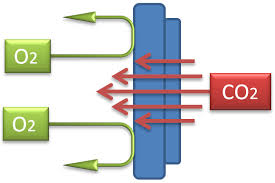
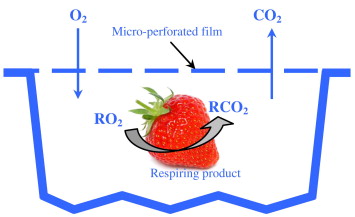
As we know that Oxygen produces lipid oxidation reactions and causes high respiration rates in food resulting shorter shelf life. Also the presence of oxygen could encourages the growth of aerobic spoilage resulting potential formation of other unwanted microorganism occurs.
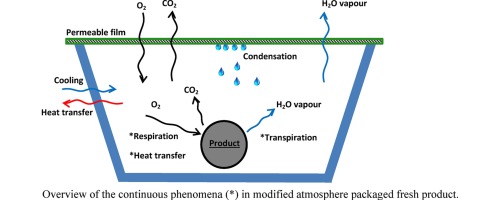
Pic source-sciencedirect
In order to reduce or delay the above growth of aerobic spoilage & formation of unwanted microorganism in food we have to reduce the oxygen to stop the oxidation reaction. By reducing the volume of oxygen contained within the empty space of the packaging containing the product & replacing it with other gases such as Co2, Nitrogen, argon, hydrogen, nobel gas, Carbon monoxide etc. Stabilizes the atmosphere of the gases contained inside the package by using active actions gas flushing & compensated vacuuming. This process is mainly achieved by using breathable shrink wraps or thin breathable films.
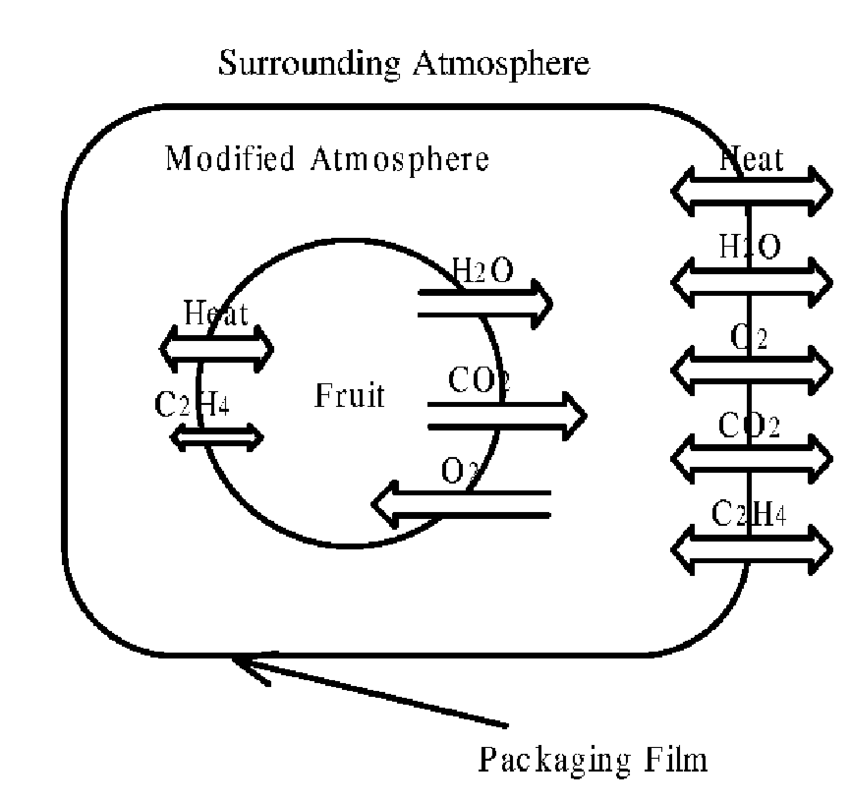
Source-research gate
In simple way we can say in MAP technique oxygen is removed or replaced by a special gas mixture such as Co2, Nitrogen, argon, hydrogen, nobel gas, Carbon monoxide etc to form a protective atmospheric layer around the food resulting shelf life, freshness & color of the food items are maintained without the use of preservatives.
Modified Atmosphere Packaging became especially important during the COVID-19 outbreak of 2020.
Is There a Difference Between Controlled Atmosphere and Modified Atmosphere Packaging?
Yes, off course.
| Controlled Atmospheric packaging | Modified Atmospheric packaging |
| CAP is storage technique rather than a shelf-ready retail tactic. It allows alterations to the storage conditions of the packaging during its lifespan. With Controlled Atmosphere, the gas composition isn’t modified straight away. But later on, using proper films or coatings. | Whereas in MAP is based on modification of air inside the package. Modified Atmosphere Packaging can be divided into two different categories:- Active MAP and Passive MAP |
| Atmosphere is continuously controlled throughout the storage period | Gas composition is modified initially creating a custom atmosphere for each product type. |
| Generally refer to decrease O2 & Increase CO2 Concentration by precise control of gas composition. | Gas composition is modified initially & it changes dynamically depending upon the respiration rate of food product & permeability of film. |
| It is more precise than MAP technique and expensive | It is less precise, cheap & economic than CAP and have No provision to alter the gaseous composition. |
| It is generally used for packaging of respiring food products such as fresh meat, poultry & fish etc. | It is generally used for non-respiring food products where microbial growth is a major food spoilage. |
What is vacuum packaging & why it is different from MAP Packaging.
In vacuum packing process, almost all the air is removed from the packet or packing containers and then it is hermetically sealed in order to maintain the vacuum. This process protects the food from oxidation in absence of air & prevents the buildup of moisture as well as inhibits the growth of oxygen –dependent micro organism.
It is not possible to pump out 100% oxygen from packets to create a total vacuum. A certain amount of oxygen will remain in vacuum packaging. As we know, oxygen is 21% in atmosphere at normal atmospheric pressure i.e 1000 millibar. By withdrawing air from packets during vacuum packing, the pressure in package will also reduce; this means that even when the pressure inside packaging is reduced to 10 milibars, there still be equivalents of 0.21% of oxygen in packets at atmospheric pressure.
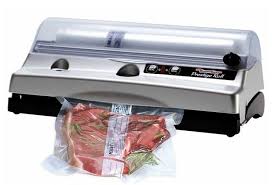
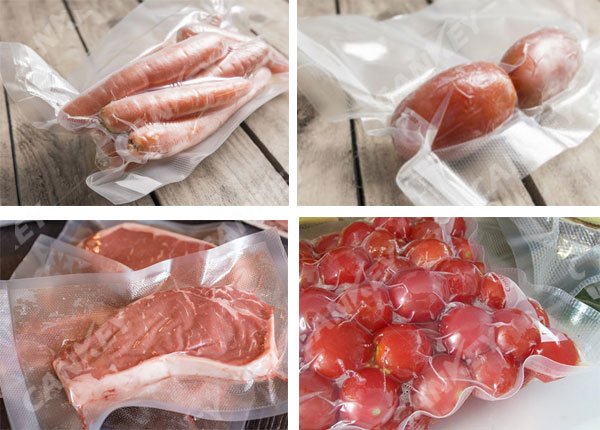
Pic source – all express & cankey
Benefit of vacuum packaging:-
- Slow down the oxidation process due to absence of oxygen from the vacuum packing packets.
- Prevent growth of oxygen-dependent microorganism.
- It prevents the buildup of moisture & maintains natural moisture in food.
- It preserves volatile oil in food.
- Vaccum packaging fresh food products especially raw meat, poultry & fish items must be stored at 2-3 degree C all the time during the shelf life.
- In short it is written as “Vac-pack”
Why it is different from MAP Packaging-
MAP Packaging is different from vacuum packaging in that it does not necessarily remove oxygen from packaging as in case of vacuum packaging which remove oxygen from packets. MAP is created by adjusting oxygen & CO2 Level to the desired value in the packaging. MAP packages are also hermitically sealed (air tight) same as vacuum packing to prevent the modified atmosphere from changing.
Ref:-
- Institute of food science & technology, Mumbai
- IIT Kanpur & Kharagpur (dept of food science & technology)
- Ministry of Food Processing Industries (MoFPI)Government of India.
- Indian Institute Of Food Science and Technology
- World wide innovation.com
- Wired.com
- Journal of food science & technology
- College of agricultural, human & natural resource, Washington state university, USA
- Cooksinfo.com
- link.springer.com
- Masterpackgroup.com
- Vortechfm.com
- Packaging Europe.com
- IIT Kanpur
- Generon.com
- Discoverfoodtech.com
- Industrialpacking.com
- Modifiedatmosphericpacking.com
- Masterclass.com
